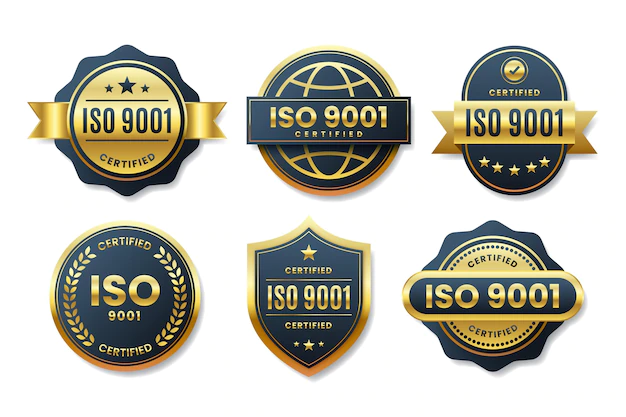
What is ISO 9001:2015 – Quality Management System?
ISO 9001:2015 is one of the most popular standard for Quality Management Systems (QMS), it was last updated in the year 2015. Developed by the International Organization for Standardization, it provides a framework for organizations to ensure consistent quality in their products and services, enhance customer satisfaction, and improve operational efficiency. The standard is applicable to any organization, regardless of its size, type, or the products and services it provides.
What is the Key Features of ISO 9001:2015
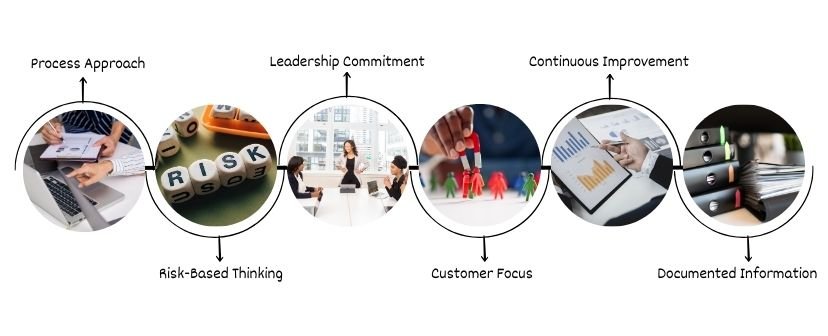
ISO 9001 Certifications Requirements
The standard is structured according to the High-Level Structure (HLS) used in other ISO management system standards. This common structure ensures compatibility and integration with other management system standards such as ISO 14001 (Environmental Management) and ISO 45001 (Occupational Health and Safety).
The Main Clauses of ISO 9001:2015 are:
-
- Scope: Defines the scope of the standard and its applicability.
-
- Normative References: Lists references to other standards that are essential for applying ISO 9001:2015.
-
- Terms and Definitions: Provides definitions of key terms used in the standard.
-
- Context of the Organization: Requires organizations to understand their context, including internal and external factors that impact their QMS.
-
- Leadership: Covers top management’s responsibilities and commitments to the QMS.
-
- Planning: Involves actions to address risks and opportunities, setting quality objectives, and planning changes.
-
- Support: Deals with resources needed for the QMS, including human resources, infrastructure, and documented information.
-
- Operation: Describes the processes needed to deliver products and services that meet customer requirements.
-
- Performance Evaluation: Involves monitoring, measurement, analysis, and evaluation of the QMS to ensure its effectiveness.
-
- Improvement: Focuses on continual improvement of the QMS, addressing nonconformities, and implementing corrective actions.
Checklist of ISO 9001 Certification
ISO 9001 Certification is use for Quality Management System, and it is accredited by internationally. There are 12 steps that help you to achieve ISO 9001:
-
- Leadership
- Perform a Gap Analysis
- Defining the scope
- Implementation of Quality Management and Creating Quality Management System Manual
- Establishing effective communication within the organization
- Creation of an audit plan
- Determining and assigning roles and responsibilities
- Evaluating the Quality Management System and taking the corrective-actions
- Conduction of an internal audit
- Apply for stage-I audit
- External audit
- Successfully completing the Certification process
What are the Key Components of ISO 9001:2015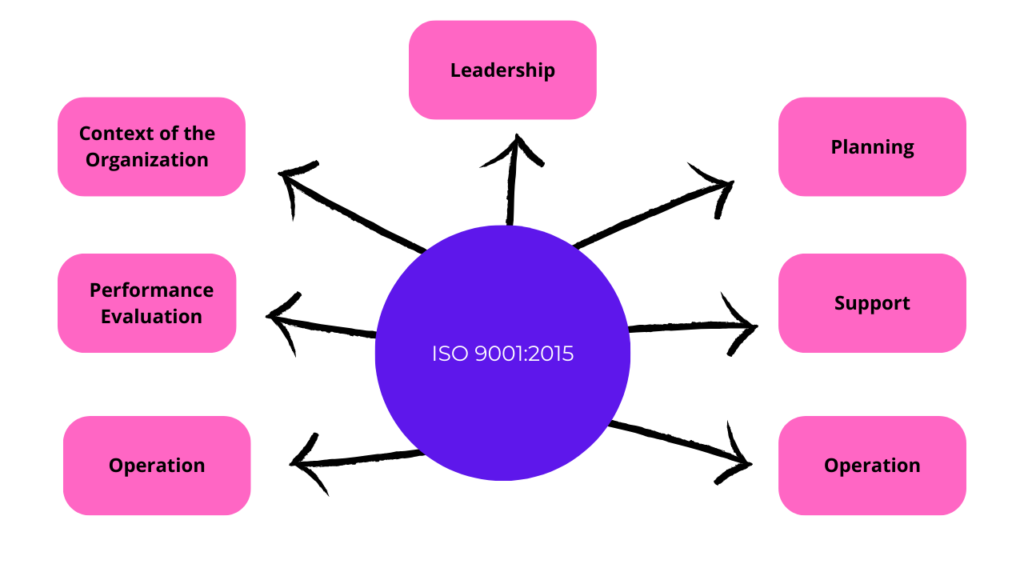
Context of the Organization:
-
- Understanding the organization and its context
-
- Understanding the needs and expectations of interested parties
-
- Determining the scope of the QMS
-
- Establishing the QMS and its processes
Leadership:
-
- Leadership and commitment from top management
-
- Establishing a quality policy
-
- Organizational roles, responsibilities, and authorities
Planning:
-
- Actions to address risks and opportunities
-
- Quality objectives and planning to achieve them
-
- Planning of changes to the QMS
Support:
-
- Resources necessary for the QMS
-
- Competence of personnel
-
- Awareness and communication
-
- Documented information to support the QMS
Operation:
-
- Planning and control of operational processes
-
- Requirements for products and services
-
- Design and development of products and services
-
- Control of externally provided processes, products, and services
-
- Production and service provision
-
- Release of products and services
-
- Control of nonconforming outputs
Performance Evaluation:
-
- Monitoring, measurement, analysis, and evaluation
-
- Internal audits to ensure compliance and effectiveness
-
- Management review of the QMS
Improvement:
-
- Identifying opportunities for improvement
-
- Managing nonconformities and taking corrective actions
-
- Continuous improvement of the QMS
Clause-wise Audit Checklist for ISO 9001:2015
Clause 4: Context of the Organization
Understanding the Organization and its Context:
-
- Have internal and external issues that affect the QMS been identified and documented?
-
- Are these issues reviewed periodically and updated as necessary?
Understanding the Needs and Expectations of Interested Parties:
-
- Have relevant interested parties and their requirements been determined?
-
- Are their needs and expectations documented and reviewed periodically?
Determining the Scope of the QMS:
-
- Is the scope of the QMS clearly defined and documented?
-
- Does the scope consider internal and external issues, requirements of interested parties, and the organization’s products and services?
QMS and its Processes:
-
- Are the processes needed for the QMS identified, including their inputs, outputs, sequence, and interaction?
-
- Are criteria and methods for the effective operation and control of these processes established?
-
- Are necessary resources for processes determined and available?
-
- Are responsibilities and authorities for these processes assigned?
-
- Are risks and opportunities associated with the processes identified and addressed?
-
- Are processes monitored, measured, analyzed, and evaluated?
Clause 5: Leadership
Leadership and Commitment:
-
- Is top management demonstrating leadership and commitment to the QMS?
-
- Are customer focus and continual improvement emphasized by top management?
-
- Are quality objectives aligned with the strategic direction of the organization?
Customer Focus:
-
- Is customer satisfaction and enhancement a priority?
-
- Are customer requirements understood and met consistently?
Quality Policy:
-
- Is there a documented quality policy?
-
- Is the quality policy communicated, understood, and applied within the organization?
Organizational Roles, Responsibilities, and Authorities:
-
- Are roles, responsibilities, and authorities clearly defined and communicated?
-
- Is a management representative assigned to oversee QMS compliance?
Clause 6: Planning
Actions to Address Risks and Opportunities:
-
- Are risks and opportunities affecting the QMS identified and documented?
-
- Are actions planned and implemented to address these risks and opportunities?
Quality Objectives and Planning to Achieve Them:
-
- Are quality objectives established and documented?
-
- Are the objectives measurable and consistent with the quality policy?
-
- Are plans in place to achieve these objectives?
Planning of Changes:
-
- Are changes to the QMS planned systematically?
-
- Are the integrity of the QMS and its processes maintained during changes?
Clause 7: Support
Resources:
-
- Are resources determined and provided to implement and maintain the QMS?
-
- Are human resources competent and adequately trained?
-
- Is infrastructure suitable and maintained?
-
- Are work environments conducive to achieving quality objectives?
Competence:
-
- Are competencies required for personnel performing work under the QMS determined?
-
- Are actions taken to acquire necessary competencies, such as training or recruitment?
Awareness:
-
- Are employees aware of the quality policy, quality objectives, and their contribution to the QMS?
Communication:
-
- Are internal and external communication processes established and implemented?
Documented Information:
-
- Is documented information required by the QMS controlled and maintained?
-
- Are documents and records appropriately managed, stored, and protected?
Clause 8: Operation
Operational Planning and Control:
-
- Are operational processes planned and controlled to meet requirements?
-
- Are criteria for processes, acceptance, and performance established?
Requirements for Products and Services:
-
- Are customer requirements determined and reviewed?
-
- Are changes to requirements reviewed and communicated effectively?
Design and Development of Products and Services:
-
- Are design and development processes planned and controlled?
-
- Are inputs, outputs, and changes documented and reviewed?
Control of Externally Provided Processes, Products, and Services:
-
- Are controls established for externally provided processes, products, and services?
-
- Are suppliers evaluated and selected based on their ability to meet requirements?
Production and Service Provision:
-
- Are production and service provision processes controlled?
-
- Are criteria for process acceptance and product release established?
Release of Products and Services:
-
- Are products and services inspected and tested before release?
-
- Are records of release maintained?
Control of Nonconforming Outputs:
-
- Are nonconforming outputs identified and controlled?
-
- Are corrective actions taken to prevent recurrence?
Clause 9: Performance Evaluation
Monitoring, Measurement, Analysis, and Evaluation:
-
- Are processes monitored and measured to ensure they achieve intended results?
-
- Are customer satisfaction data collected and analyzed?
-
- Are internal audits conducted regularly to evaluate QMS effectiveness?
Internal Audit:
-
- Are internal audits planned and conducted according to the audit program?
-
- Are audit results documented and communicated to management?
Management Review:
-
- Are management reviews conducted regularly?
-
- Are inputs to management reviews comprehensive and based on QMS performance data?
-
- Are decisions and actions from management reviews documented and followed up?
Clause 10: Improvement
Nonconformity and Corrective Action:
-
- Are nonconformities identified and controlled?
-
- Are corrective actions taken to address nonconformities and prevent recurrence?
Continual Improvement:
-
- Are opportunities for improvement identified and implemented?
-
- Is the effectiveness of improvement actions monitored and reviewed?
Non-Auditable Clauses- ISO 9001
Clause 1: Scope
-
- Defines the scope of ISO 9001:2015 and its intended application.
-
- Provides information on the applicability of the standard but is not a requirement to be audited against.
Clause 2: Normative References
-
- Lists references to other documents that are indispensable for the application of ISO 9001:2015.
-
- This clause itself does not contain auditable requirements.
Clause 3: Terms and Definitions
-
- Provides definitions for terms used in the standard.
-
- This clause is intended to clarify terminology and ensure a common understanding but is not auditable.
Plan-Do-Check-Act (PDCA) Explained
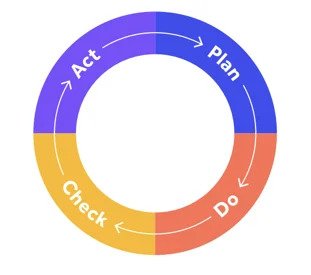
Plan:
-
- Establish Objectives and Processes: Determine what needs to be done to achieve the desired results and set objectives.
-
- Identify Risks and Opportunities: Analyze potential risks and opportunities that could impact the QMS and plan actions to address them.
-
- Define Resources: Identify the resources needed to achieve the objectives and ensure they are available.
-
- Develop Procedures: Create procedures and processes necessary to implement the plan.
Do:
-
- Implement the Plan: Execute the planned activities and processes.
-
- Train and Communicate: Ensure that personnel are adequately trained and informed about their roles and responsibilities.
-
- Collect Data: Gather data during the implementation phase to monitor and measure performance.
Check:
-
- Monitor and Measure: Assess the performance of processes against the planned objectives and criteria.
-
- Analyze Data: Review the collected data to identify any deviations from the plan and understand their causes.
-
- Internal Audits: Conduct internal audits to evaluate the effectiveness of the QMS and compliance with ISO 9001:2015 requirements.
-
- Management Review: Review the performance and effectiveness of the QMS with top management to ensure it meets the organization’s objectives.
Act:
-
- Take Corrective Actions: Address any nonconformities and take actions to prevent their recurrence.
-
- Implement Improvements: Based on the findings from the “Check” phase, make necessary adjustments and improvements to the processes.
-
- Review and Update: Ensure that changes are documented and communicated to all relevant parties.
-
- Standardize Best Practices: Integrate successful improvements into standard operating procedures to ensure continuous improvement.
Application of PDCA in ISO 9001:2015 Clauses
Clause 4: Context of the Organization (Plan)
-
- Identify internal and external issues, understand the needs of interested parties, and determine the scope of the QMS.
Clause 5: Leadership (Plan, Do)
-
- Establish quality policy and objectives, assign roles and responsibilities, and demonstrate leadership commitment.
Clause 6: Planning (Plan)
-
- Address risks and opportunities, set quality objectives, and plan changes to the QMS.
Clause 7: Support (Do)
-
- Provide necessary resources, ensure competence and awareness, manage communication, and control documented information.
Clause 8: Operation (Do)
-
- Plan and control operational processes, design and develop products, control externally provided processes, and manage production and service provision.
Clause 9: Performance Evaluation (Check)
-
- Monitor, measure, analyze, and evaluate processes, conduct internal audits, and perform management reviews.
Clause 10: Improvement (Act)
-
- Identify nonconformities, implement corrective actions, and pursue continual improvement.
ISO 9001 Certification Requirements: Implementing ISO 9001:2015
Implementing ISO 9001:2015 involves meeting specific requirements outlined in its clauses. Each clause addresses different aspects of a Quality Management System (QMS).
Below are the steps to implementing ISO 9001:2015 clause by clause:
Clause 4: Context of the Organization
Understanding the Organization and Its Context:
-
- Identify internal and external issues relevant to the QMS.
-
- Document and review these issues periodically.
Understanding the Needs and Expectations of Interested Parties:
-
- Determine relevant interested parties and their requirements.
-
- Document and regularly review these requirements.
Determining the Scope of the QMS:
-
- Define the boundaries and applicability of the QMS.
-
- Document the scope, considering internal and external issues, interested parties, and the products and services offered.
Quality Management System and Its Processes:
-
- Identify necessary QMS processes, their sequence, and interaction.
-
- Define criteria and methods for these processes, including responsibilities, resources, and risk management.
-
- Monitor, measure, and analyze processes, and implement actions for continual improvement.
Clause 5: Leadership
Leadership and Commitment:
-
- Ensure top management demonstrates leadership and commitment to the QMS.
-
- Promote a focus on customer requirements and continual improvement.
Customer Focus:
-
- Ensure customer needs and expectations are met consistently.
Quality Policy:
-
- Develop a quality policy aligned with the organization’s context and strategic direction.
-
- Communicate the quality policy within the organization.
Organizational Roles, Responsibilities, and Authorities:
-
- Define and communicate roles, responsibilities, and authorities related to the QMS.
-
- Ensure accountability for the effectiveness of the QMS.
Clause 6: Planning
Actions to Address Risks and Opportunities:
-
- Identify and document risks and opportunities that could affect the QMS.
-
- Plan actions to address these risks and opportunities.
Quality Objectives and Planning to Achieve Them:
-
- Set measurable quality objectives aligned with the quality policy.
-
- Plan how to achieve these objectives, including necessary resources and responsible parties.
Planning of Changes:
-
- Plan and manage changes to the QMS to ensure its integrity is maintained.
-
- Document and communicate changes as necessary.
Clause 7: Support
Resources:
-
- Determine and provide resources needed for the QMS, including people, infrastructure, and work environment.
Competence:
-
- Ensure personnel are competent based on appropriate education, training, and experience.
-
- Document competence requirements and maintain records of training and evaluation.
Awareness:
-
- Ensure employees are aware of the quality policy, relevant objectives, their contributions to the QMS, and the implications of not conforming to QMS requirements.
Communication:
-
- Establish effective internal and external communication processes relevant to the QMS.
Documented Information:
-
- Determine necessary documented information to support the QMS.
-
- Control documented information to ensure it is accessible, protected, and retained as needed.
Clause 8: Operation
Operational Planning and Control:
-
- Plan and control processes needed to meet requirements for products and services.
-
- Ensure criteria for processes and acceptance are established.
Requirements for Products and Services:
-
- Determine and review customer requirements before committing to supply products and services.
Design and Development of Products and Services:
-
- Plan and control the design and development process.
-
- Ensure inputs are adequate, outputs meet requirements, and changes are controlled.
Control of Externally Provided Processes, Products, and Services:
-
- Establish criteria for evaluating and selecting suppliers.
-
- Ensure external providers conform to specified requirements.
Production and Service Provision:
-
- Control production and service provision processes, including equipment, environment, and release of products and services.
Release of Products and Services:
-
- Ensure products and services are inspected and tested before release to customers.
-
- Maintain records of release and verification.
Control of Nonconforming Outputs:
-
- Identify, control, and manage nonconforming outputs to prevent unintended use or delivery.
-
- Take corrective actions as necessary.
Clause 9: Performance Evaluation
Monitoring, Measurement, Analysis, and Evaluation:
-
- Monitor and measure QMS performance, including customer satisfaction.
-
- Analyze and evaluate data to ensure the effectiveness of the QMS.
Internal Audit:
-
- Plan and conduct internal audits to evaluate QMS conformance and effectiveness.
-
- Document audit results and take corrective actions as needed.
Management Review:
-
- Conduct regular management reviews to assess QMS performance and identify improvement opportunities.
-
- Ensure inputs to the management review are comprehensive and outputs include decisions and actions for improvement.
Clause 10: Improvement
General:
-
- Identify opportunities for improvement and implement actions to enhance QMS performance.
Nonconformity and Corrective Action:
-
- Address nonconformities and take corrective actions to prevent recurrence.
-
- Document actions taken and evaluate their effectiveness.
Continual Improvement:
-
- Promote a culture of continual improvement within the organization.
-
- Use data and feedback to drive improvements in processes and the QMS.
Steps to Achieve ISO 9001:2015 Certification
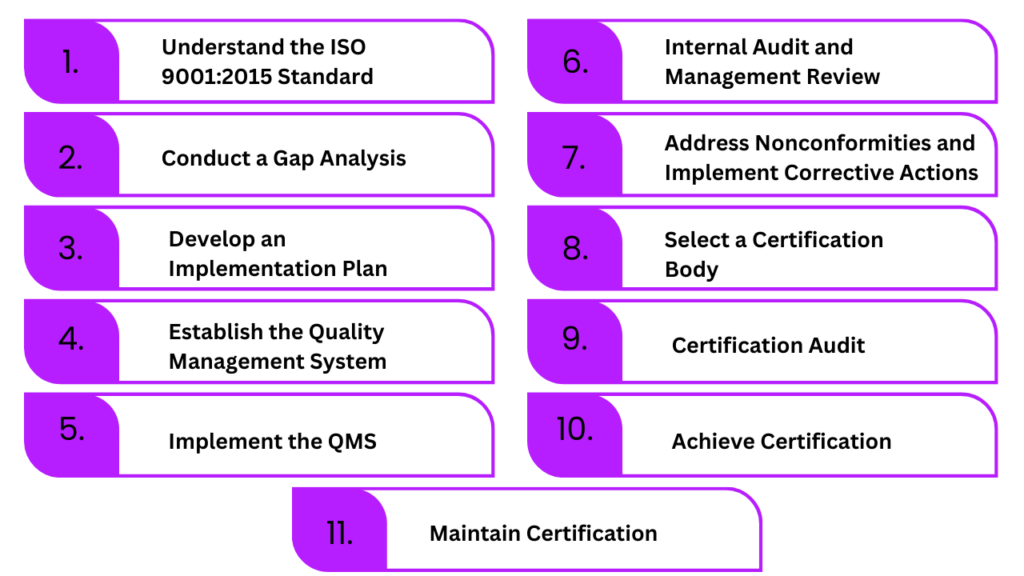
Achieving ISO 9001:2015 certification involves a series of systematic steps to establish, implement, and maintain an effective Quality Management System (QMS).
Below is a detailed guide to the process:
Understand the ISO 9001:2015 Standard
-
- Acquire a copy of the ISO 9001:2015 standard and study its clauses to understand the requirements.
-
- Provide training for key personnel to ensure they understand the standard and its implementation.
Conduct a Gap Analysis
-
- Compare your existing quality management processes against the requirements of ISO 9001:2015.
-
- Identify Gaps: Document areas where the current system does not meet the standard’s requirements.
-
- Plan for Closing Gaps: Develop an action plan to address the identified gaps.
Develop an Implementation Plan
-
- Define clear objectives and timelines for achieving ISO 9001:2015 certification.
-
- Identify a project leader or team responsible for the implementation and assign roles and responsibilities.
-
- Ensure that adequate resources, including time, budget, and personnel, are allocated for the implementation process.
Establish the Quality Management System
-
- Identify and document the processes necessary for the QMS, including their interactions and sequences.
-
- Develop a quality policy and set measurable quality objectives aligned with the organization’s context and strategic direction.
-
- Prepare necessary documented information, including procedures, work instructions, and records.
Implement the QMS
-
- Inform all employees about the implementation plan and their roles in the QMS.
-
- Provide training to ensure employees understand their roles in the QMS and are aware of the quality policy and objectives.
-
- Implement the documented processes and control measures across the organization.
Internal Audit and Management Review
-
- Perform internal audits to evaluate the effectiveness of the QMS and identify areas for improvement.
-
- Hold management review meetings to assess the QMS performance, review audit findings, and make decisions on necessary actions.
Address Nonconformities and Implement Corrective Actions
-
- Document any nonconformities found during internal audits or daily operations.
-
- corrective actions to address nonconformities and prevent their recurrence.
-
- Use the findings from audits and reviews to drive continual improvement of the QMS.
Select a Certification Body
-
- Research Certification Bodies: Choose an accredited certification body that is reputable and has experience in your industry.
-
- Request Proposal from the certification body.
-
- Select and Schedule the certification audit.
Certification Audit
-
- Stage 1 Audit (Document Review): The certification body will review your documented information to ensure it meets ISO 9001 requirements.
-
- Stage 2 Audit (On-Site Audit): The CB will conduct an on-site/Online audit to verify the implementation and effectiveness of your QMS.
-
- Audit Findings: Address any nonconformities or observations identified during the audit.
Achieve Certification
-
- Certification Decision: Once the certification body verifies that your QMS meets the ISO 9001:2015 requirements, they will issue a certification.
-
- Celebrate and Communicate: Announce your certification to stakeholders, customers, and employees. Highlight the achievement in marketing and communication materials.
Maintain Certification
-
- Surveillance Audits: Participate in regular surveillance audits conducted by the certification body to ensure continued compliance with ISO 9001:2015.
-
- Continuous Improvement: Continually improve the QMS by monitoring performance, addressing nonconformities, and implementing corrective actions.
-
- Recertification: Undergo recertification audits as required (every three years) to maintain your certification status.
Achieving ISO 9001:2015 certification is a comprehensive process that involves understanding the standard, conducting a gap analysis, developing and implementing a QMS, undergoing internal audits, and successfully completing certification audits.
Who Needs ISO 9001:2015-Quality Management System?
ISO 9001:2015 is the only ISO standard that is applicable to all industries and all companies, Implementing ISO 9001 helps organizations of all sizes and sectors to streamline their processes, enhance customer satisfaction, and achieve continual improvement. It is a versatile standard that can be tailored to meet the specific needs of any organization committed to quality management.
This standard is commonly used by:
- Manufacturing Companies: Ensures consistency in product quality, reduces defects, and improves overall efficiency.
- Service Providers: Enhances service delivery, customer satisfaction, and operational processes.
- Construction Firms: Standardizes project management processes, ensuring quality and safety.
- Healthcare Organizations: Improves patient care quality, operational efficiency, and compliance with regulatory requirements.
- Educational Institutions: Enhances educational services, administrative efficiency, and stakeholder satisfaction.
- Government Agencies: Streamlines operations, improves public service quality, and ensures regulatory compliance.
- Retail Businesses: Increases customer satisfaction, improves product quality, and optimizes supply chain management.
- Information Technology Companies: Ensures quality in software development, IT services, and customer support.
- Information Technology Companies: Ensures quality in software development, IT services, and customer support.
- Automotive Industry: Improves production processes, reduces defects, and enhances product quality.
- Logistics and Transportation: Enhances service reliability, customer satisfaction, and operational efficiency.
- Financial Services: Improves service quality, operational processes, and customer trust.
- Non-Profit Organizations: Enhances operational efficiency, stakeholder satisfaction, and transparency.
- Telecommunications: Ensures quality in service delivery, customer satisfaction, and operational efficiency.
- Pharmaceutical Companies: Ensures quality in production processes, regulatory compliance, and product safety.
- Real Estate Firms: Enhances property management processes, customer satisfaction, and operational efficiency.
- Energy and Utilities: Improves operational efficiency, regulatory compliance, and service reliability.
- Hospitality Industry: Enhances service quality, customer satisfaction, and operational processes.
- Legal Services: Improves service delivery, client satisfaction, and operational efficiency.
- Research and Development Organizations: Ensures quality in research processes, innovation, and stakeholder satisfaction.
At last, Pacific Certifications is accredited by ABIS, Click here to apply for ISO 9001:2015 or get in touch with us at +91-8595603096 or support@pacificcert.com
Suggested Certifications –









